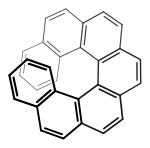Axial chirality
Axial chirality is a special case of chirality in which a molecule does not possess a stereogenic center (the most common form of chirality in organic compounds) but an axis of chirality – an axis about which a set of substituents is held in a spatial arrangement that is not superposable on its mirror image. Axial chirality is most commonly observed in atropisomeric biaryl compounds wherein the rotation about the aryl-aryl bond is restricted, for example, biphenyl, binaphthyls, e.g., 1,1'-bi-2-naphthol, and certain dihydroanthracenone compounds.[1] Certain allene compounds and spirans also display axial chirality. The enantiomers of axially chiral compounds are usually given the stereochemical labels Ra and Sa.[2] The designations are based on the same Cahn-Ingold-Prelog priority rules used for tetrahedral stereocenters. The chiral axis is viewed end-on and the two "near" and two "far" substituents on the axial unit are ranked, but with the additional rule that the near substituents have higher priority than the far ones.


This property can also be called helicity, since the axis of the structure has a helical, propeller, or screw-shaped geometry. P (plus) or Δ is a right-handed helix, where M (minus) or Λ is a left-handed helix.[3][4] The P/M or Δ/Λ terminology is used particularly for molecules that actually resemble a helix, such as hexahelicene. It can also be applied to other structures having axial chirality by considering the helical orientation of the "front" vs "back" Cahn–Ingold–Prelog rankings.


External links
References
- ↑ Absolute stereochemistry of fungal metabolites: Icterinoidins A1 and B1, and atrovirins B1 and B2 Melvyn Gill and Peter M. Morgan Arkivoc (RI-1154C)2004 Online article
- ↑ Compendium of Chemical Terminology, axial chirality
- ↑ Compendium of Chemical Terminology, helicity
- ↑ VLU: Additional Chirality Elements - Chemgapedia